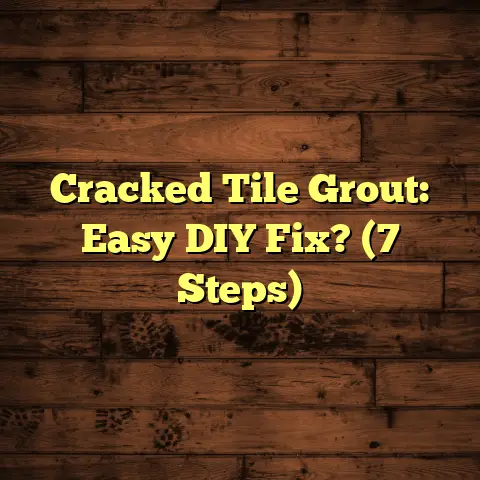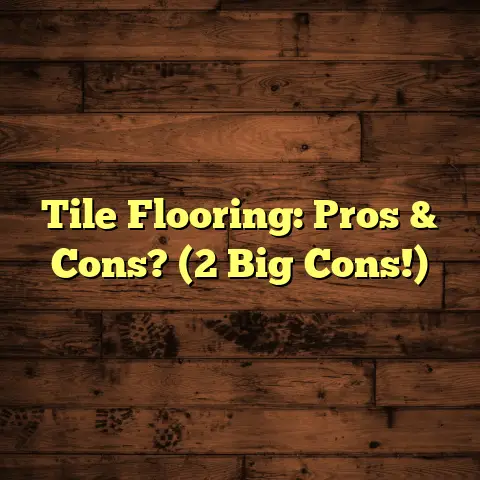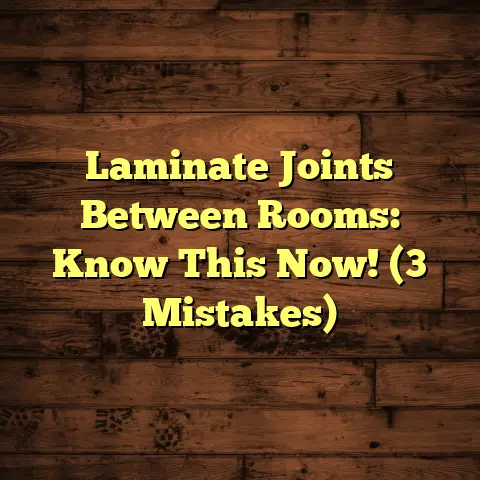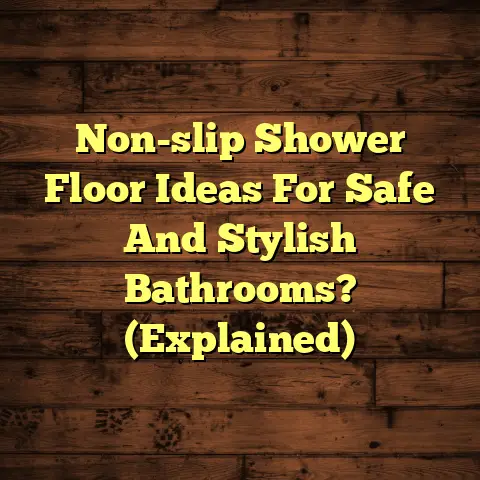How To Fix Slippery Wood Floors? (2 Fall Hazards!)
Yeah, not fun, especially when it’s unintentional.
I’m a flooring contractor, and I’ve seen firsthand how beautiful wood floors can become a safety hazard when they turn into an ice rink.
We all love the look and feel of hardwood, its adaptability to any interior style, from rustic farmhouse to sleek modern.
But let’s be real: a slippery wood floor is an accident waiting to happen.
This article isn’t just about aesthetics; it’s about safety.
I’m going to walk you through the common causes of slippery wood floors, highlight the dangers they pose, and, most importantly, give you practical, actionable solutions to reclaim your floors and prevent nasty falls.
Think of this as your comprehensive guide to a safer, more secure home. Let’s get started!
Section 1: Understanding the Causes of Slippery Wood Floors
So, what makes a wood floor slippery in the first place? It’s rarely just one thing. Usually, it’s a combination of factors working against you.
Let’s break down the usual suspects.
-
The Type of Finish:
This is a big one. Polyurethane finishes, especially those with a high-gloss sheen, are notorious for being slippery. They create a hard, smooth surface that, while durable, doesn’t offer much grip. Lacquer finishes can also contribute to this issue.
Think of it like this: the shinier the floor, the slicker the slide.
-
Environmental Conditions:
Humidity and temperature changes can wreak havoc on wood floors.
High humidity can cause wood to expand, which can lead to a buildup of moisture on the surface, making it slippery.
Conversely, very dry conditions can cause the wood to contract, creating tiny gaps where dust and debris can accumulate, further reducing traction.
-
Spills, Dust, and Debris:
This seems obvious, but it’s often overlooked. Even a seemingly harmless spill of water or a thin layer of dust can significantly reduce the floor’s grip.
Think about it: dust acts like tiny ball bearings under your feet.
And spills? Well, they speak for themselves.
-
Wear and Tear Over Time:
Over time, the finish on your wood floor will wear down, especially in high-traffic areas. This wear can create smooth patches that are much more slippery than the surrounding areas.
Also, older finishes might become brittle and crack, creating an uneven surface that compromises traction.
Understanding these causes is the first step in fixing the problem. By identifying the specific factors contributing to the slipperiness of your floors, you can tailor your approach and choose the most effective solutions.
For instance, if you know your high-gloss polyurethane is the main culprit, you might consider refinishing with a less slippery finish.
Or, if you live in a humid climate, investing in a dehumidifier might be the key to keeping your floors dry and safe.
Section 2: The Importance of Addressing Fall Hazards
Okay, so slippery floors are annoying, but why is it really important to fix them?
Beyond the occasional embarrassing slip, there are some serious risks to consider. Let’s talk about two major fall hazards.
-
The Risk of Serious Injuries:
Falls are no joke, especially for young children and older adults. According to the CDC, each year, millions of older people—those 65 and older—fall. In fact, more than one out of four older people falls each year, but less than half tell their doctor. Falling once doubles your chances of falling again. (CDC Fall Facts)
Falls can lead to fractures (especially hip fractures), head injuries, and other debilitating conditions.
Even a seemingly minor fall can result in a sprain, strain, or bruise that limits mobility and impacts quality of life.
I’ve seen firsthand how a simple slip on a wood floor can lead to months of recovery and rehabilitation.
-
The Financial Implications:
Beyond the physical pain and suffering, falls can also have significant financial consequences.
Medical bills from emergency room visits, doctor appointments, physical therapy, and medication can quickly add up.
And if the fall occurs due to negligence (for example, if you knew about a slippery floor and didn’t take steps to fix it), you could potentially be liable for someone else’s injuries.
According to the National Safety Council, the average cost of a fall injury is around $30,000. (National Safety Council)
That’s a hefty price to pay for something that could have been prevented.
Ignoring slippery floors isn’t just a matter of convenience; it’s a matter of safety and financial responsibility. Taking proactive steps to address these hazards can protect yourself, your family, and your guests from potential harm and expense.
Section 3: Immediate Solutions to Reduce Slipperiness
Alright, let’s get down to brass tacks. You’ve identified the problem, you understand the risks, now what can you do right now to make your floors less slippery? Here are some immediate solutions that can provide quick relief.
-
Cleaning Techniques:
This might seem obvious, but the right cleaning routine can make a huge difference.
-
Regular Cleaning: Sweep or vacuum your wood floors regularly to remove dust, dirt, and debris.
-
The Right Products: Use a pH-neutral cleaner specifically designed for wood floors. Avoid harsh chemicals, abrasive cleaners, and anything that leaves a residue. I recommend products like Bona or Method Wood Floor Cleaner.
-
Proper Technique: Use a damp mop, not a soaking wet one. Excess water can damage wood floors. Always wring out the mop thoroughly before applying it to the floor.
-
Spot Cleaning: Clean up spills immediately. The longer a spill sits, the more likely it is to soak into the floor and create a slippery residue.
-
-
Application of Non-Slip Treatments:
There are several non-slip treatments available that can increase the traction of your wood floors.
-
Non-Slip Sprays: These sprays create a textured surface that provides better grip. Look for products specifically designed for wood floors and follow the manufacturer’s instructions carefully. Be sure to test the spray in an inconspicuous area first to ensure it doesn’t damage the finish.
-
Mats and Rugs: Strategically place mats and rugs in high-traffic areas, such as entryways, hallways, and in front of sinks and stoves. Choose rugs with non-slip backings or use rug pads to prevent them from sliding.
-
Anti-Slip Tapes: These tapes can be applied to stairs or other areas where extra traction is needed.
-
-
Temporary Solutions:
Sometimes, you need a quick fix while you’re working on a more permanent solution.
-
Furniture Placement: Arrange furniture to create barriers or to cushion areas that are particularly slippery. For example, place a coffee table in front of a slippery area to discourage people from walking there.
-
Warning Signs: If you have a known slippery spot, place a warning sign to alert people to the hazard.
-
Socks and Footwear: Encourage family members and guests to wear socks or shoes with good traction. Avoid walking on wood floors in bare feet or socks, as this can increase the risk of slipping.
-
These immediate solutions can provide a significant improvement in the safety of your wood floors. While they might not be permanent fixes, they can help reduce the risk of falls while you’re working on more long-term solutions.
Section 4: Long-term Fixes for Slippery Wood Floors
Okay, you’ve got the immediate solutions in place, but what about a more permanent fix?
Let’s dive into some long-term strategies for making your wood floors safer.
-
Refinishing the Floor:
This is the most comprehensive solution, but also the most involved. Refinishing involves sanding down the existing finish and applying a new one.
-
Sanding: Sanding removes the old, worn-out finish and creates a smooth, even surface for the new finish to adhere to. This is a crucial step, so be sure to use the right grit sandpaper and follow proper sanding techniques.
-
Choosing the Right Finish: This is where you can make a big difference in the slipperiness of your floors. Opt for a finish with a lower sheen, such as a matte or satin finish. These finishes provide better grip than high-gloss finishes.
-
Application: Apply the finish according to the manufacturer’s instructions. Use multiple thin coats rather than one thick coat for a more durable and even finish.
-
-
Choosing the Right Finish:
Let’s talk more about those finish options.
-
Water-Based Polyurethane: Water-based polyurethanes are generally less slippery than oil-based polyurethanes. They also tend to have lower VOCs (volatile organic compounds), making them a more environmentally friendly choice.
-
Oil-Based Polyurethane: While durable, oil-based polyurethanes tend to be more slippery than water-based options. If you choose an oil-based polyurethane, opt for a matte or satin finish.
-
Penetrating Oil Finishes: These finishes penetrate the wood rather than sitting on top of it. They provide a more natural look and feel and tend to be less slippery than polyurethane finishes. However, they require more maintenance.
-
Adding Additives: You can add anti-slip additives to your finish to increase its traction. These additives are typically fine powders that are mixed into the finish before application.
-
-
Installing Anti-Slip Products:
There are a variety of anti-slip products designed specifically for wood floors.
-
Anti-Slip Strips: These strips are typically made of rubber or textured plastic and can be applied to stairs or other areas where extra traction is needed.
-
Anti-Slip Coatings: These coatings are applied to the entire floor surface and create a textured finish that provides better grip.
-
Area Rugs with Non-Slip Backing: As mentioned earlier, strategically placed area rugs can significantly reduce the risk of falls. Choose rugs with non-slip backings or use rug pads to prevent them from sliding.
-
These long-term fixes require more time and effort, but they provide a more permanent solution to slippery wood floors. By refinishing with a less slippery finish or installing anti-slip products, you can create a safer and more secure home environment.
Section 5: Preventative Measures to Maintain Safety
You’ve fixed the immediate problem, you’ve implemented long-term solutions, but the work doesn’t stop there.
Maintaining safety on your wood floors requires ongoing effort. Let’s talk about preventative measures.
-
Routine Maintenance Practices:
-
Regular Inspections: Inspect your wood floors regularly for signs of wear and tear, such as scratches, cracks, or worn areas. Address these issues promptly to prevent them from becoming safety hazards.
-
Cleaning Schedule: Establish a regular cleaning schedule to remove dust, dirt, and debris. Sweep or vacuum your floors at least once a week, and mop them as needed with a pH-neutral cleaner.
-
Professional Cleaning: Consider hiring a professional floor cleaning service periodically to deep clean your floors and remove stubborn stains and residues.
-
-
Controlling Indoor Humidity Levels:
-
Dehumidifiers: If you live in a humid climate, use a dehumidifier to keep indoor humidity levels between 30% and 50%.
-
Air Conditioners: Air conditioners can also help reduce indoor humidity levels.
-
Proper Ventilation: Ensure proper ventilation in your home to prevent moisture buildup.
-
-
Educating Family Members and Guests:
-
Safe Practices: Educate family members and guests about safe practices on wood floors, such as wearing appropriate footwear and avoiding running or playing on slippery surfaces.
-
Spill Awareness: Remind everyone to clean up spills immediately to prevent them from becoming slip hazards.
-
Warning Signs: If you have areas that are prone to slipperiness, post warning signs to alert people to the hazard.
-
By implementing these preventative measures, you can maintain the safety of your wood floors and prevent future falls.
Section 6: When to Consult Professionals
Sometimes, despite your best efforts, the problem is just too big to handle on your own. When should you call in the pros?
-
Extensive Damage or Severe Slipperiness:
If your wood floors are severely damaged or extremely slippery, DIY solutions might not be enough.
Cracks, warping, or extensive wear and tear can compromise the structural integrity of the floor and require professional repair or replacement.
Similarly, if you’ve tried various cleaning and anti-slip treatments without success, it’s time to consult a flooring specialist.
-
Benefits of Professional Assessments:
A professional flooring contractor can assess the condition of your floors and identify the underlying causes of slipperiness.
They can also recommend the most effective solutions based on your specific needs and budget.
A professional assessment can save you time, money, and frustration by ensuring that you’re addressing the problem correctly.
-
Guidelines for Selecting Reputable Contractors:
-
Check Credentials: Verify that the contractor is licensed and insured.
-
Read Reviews: Look for online reviews and testimonials from previous customers.
-
Get Multiple Quotes: Obtain quotes from several contractors and compare their prices and services.
-
Ask for References: Ask the contractor for references and contact them to inquire about their experience.
-
Review the Contract: Carefully review the contract before signing it to ensure that it includes all the details of the project, including the scope of work, materials, and payment schedule.
-
Don’t hesitate to seek professional help if you’re unsure how to address slippery wood floors. A qualified flooring contractor can provide expert advice and ensure that your floors are safe and secure.
Conclusion
So, there you have it: a comprehensive guide to fixing slippery wood floors and preventing falls.
We’ve covered everything from the common causes of slipperiness to immediate solutions, long-term fixes, and preventative measures.
Remember, slippery wood floors are a serious safety hazard, but they can be effectively managed with the right knowledge and tools.
Don’t wait for an accident to happen. Take proactive steps to assess your floors, implement the appropriate solutions, and maintain a safe and secure home environment.
I urge you to take action today. Inspect your wood floors for potential slip hazards, implement the solutions we’ve discussed, and educate your family members and guests about safe practices.
By working together, we can create safer living spaces for everyone.





